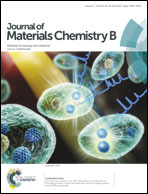Nanocomposite biomaterials based on poly(ether-ether-ketone) (PEEK) and WS2 inorganic nanotubes
Abstract
The manuscript presents the use of tungsten disulfide inorganic nanotubes (INT-WS2) to fabricate advanced poly(ether ether ketone) (PEEK) biomaterials by a traditional melt processing technique. This strategy offers an attractive way to combine the merits of organic and inorganic materials into novel hybrid systems with improved performance. The effect of INT-WS2 content on the morphology, thermal stability, crystallization behaviour, thermal conductivity, mechanical and tribological properties is investigated in detail with various techniques. The results indicate that these inorganic nanotubes can be efficiently incorporated into the biopolymer matrix without the need for modifiers or surfactants, resulting in a very homogenous dispersion. Additionally, it is found that the increase in INT-WS2 concentration leads to changes in the crystallization behaviour without modifying the crystalline structure of PEEK in the nanocomposites. The incorporation of INT-WS2 produces higher improvements in the degradation temperature, storage modulus, thermal expansion coefficient, hardness, coefficient of friction and wear resistance of the polymer than the addition of other inorganic nanofillers or carbon nanotubes, providing an effective balance between performance, cost effectiveness and processability. These novel nanocomposites are of great interest for use in biomedical applications, particularly for orthopaedic and trauma implants.


 Please wait while we load your content...
Please wait while we load your content...